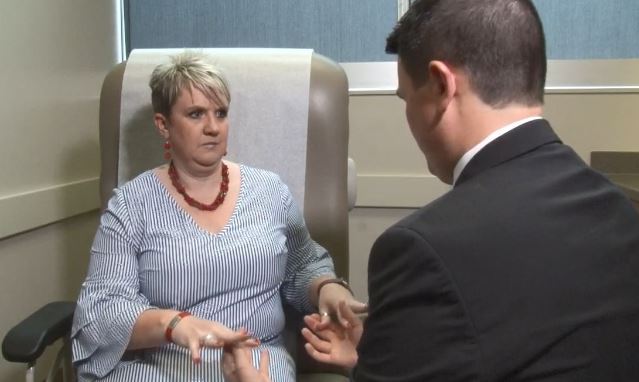View Larger Image

Christopher Paul, M.D. visits with his patient Joyce Williamson.
Spinal Cord Stimulator Virtually Erases Woman’s Chronic Pain
| Sept. 6, 2018| For 18 months, Joyce Williamson lived with constant pain. The discomfort was so intense that there were days she did not want to get out of bed.
“Being in pain takes a lot out of you,” Williamson said. “It was constant, burning, bone-crushing pain. It affected my work, everything. I was beginning to feel depressed.”
Williamson’s pain began shortly after a surgery she had in 2016 on her wrist. She developed an inflammatory condition called complex regional pain syndrome (CRPS). CRPS affects the nervous system and often causes severe pain in one limb like an arm, leg, hand or foot. Williamson felt it in her wrist and shoulder.
Medication and physical therapy can provide relief for some patients. Williamson tried several interventions to alleviate the pain, but none of them worked for her. In March 2018, she saw Christopher Paul, M.D., an assistant professor in the UAMS College of Medicine Department of Anesthesiology, for a surgery that included an implanted device known as a spinal cord stimulator (SCS).
“It works almost like a pacemaker does for the heart,” Paul said. “An SCS is implanted into the epidural space, the area between vertebrae. It sends electrical pulses to block the feeling of pain.”
Lauren Byers, A.P.R.N works alongside Paul. She says she’s inspired to see patients like Williamson get their life back.
“Just hearing that she is able to play with her grandchildren and return to work without any setbacks after being in constant pain for the past several months is huge.”
Byers says unlike many procedures, patients are able to test-drive, so to speak, the spinal cord stimulator before having it permanently placed.
“It worked so well,” Williamson said of the trial. “I didn’t want to give it back.
Before the surgery, Williamson says her pain was at a constant 8 or 9 on a scale of 1-10.
“After surgery, my pain level has been at a 1 or 2, which is like a zero to me,” Williamson said. “I feel like I have my life back.
Williamson has been able to get off four types of medications in the 10 weeks since the surgery. She’s back to her normal activities and playing in the floor with her two young grandchildren. She returned to work within a month after the procedure and says even her colleagues noticed a change.
‘“We have the old you back,’ they told me. I feel like I have my life back.”

